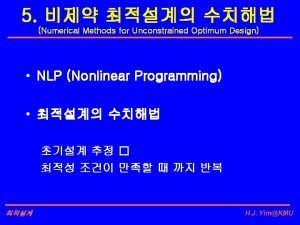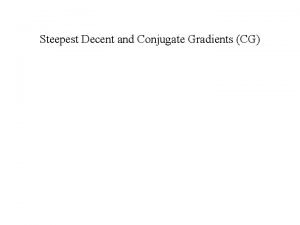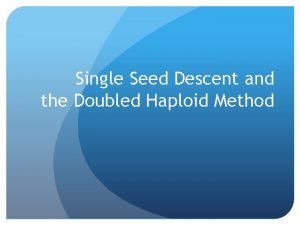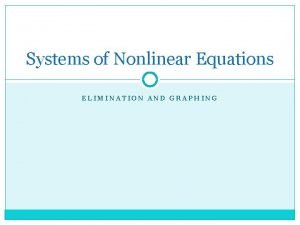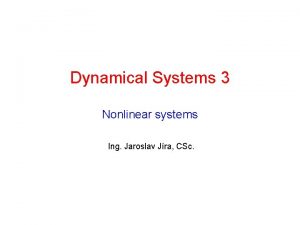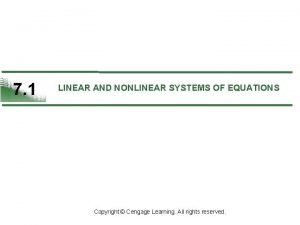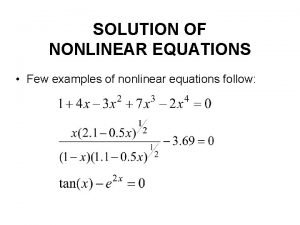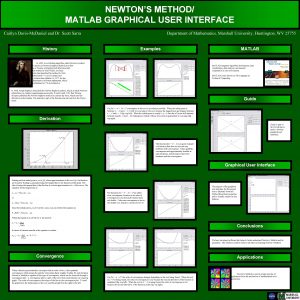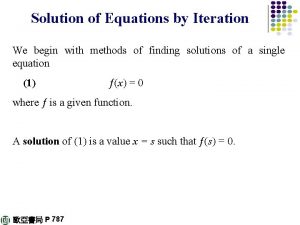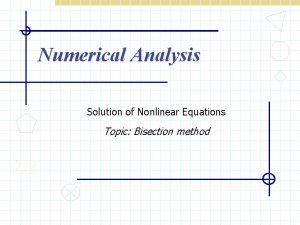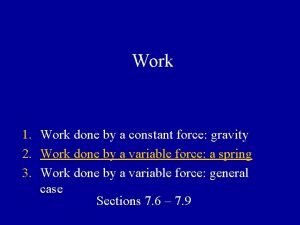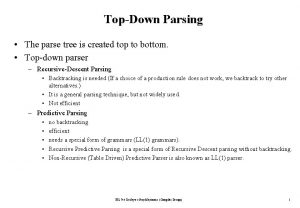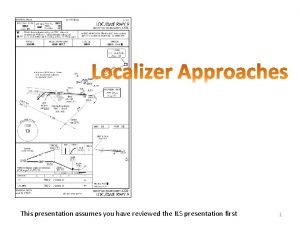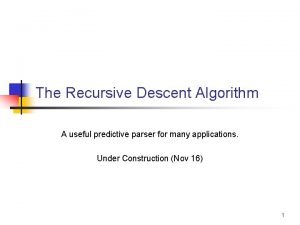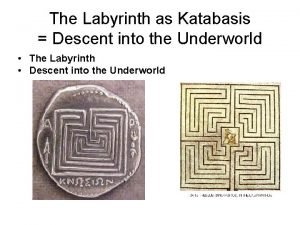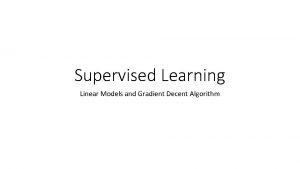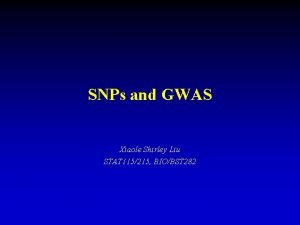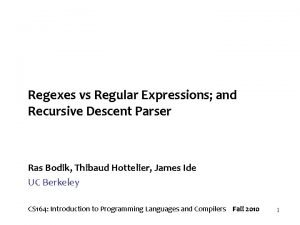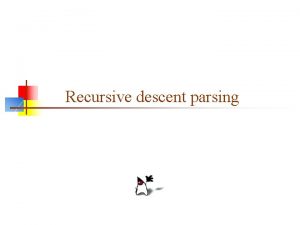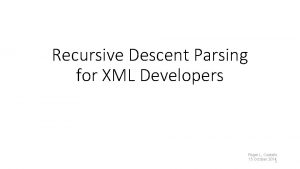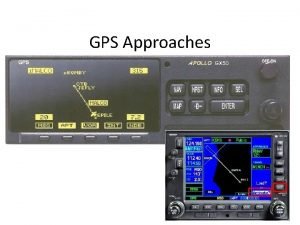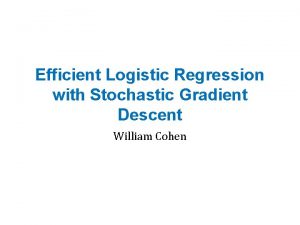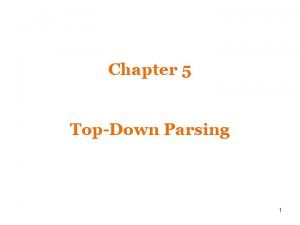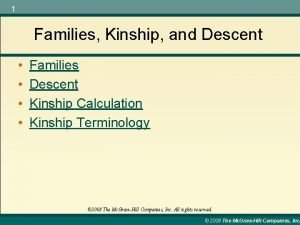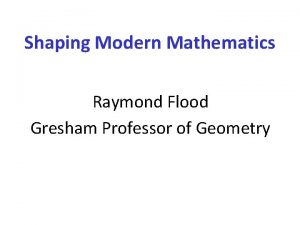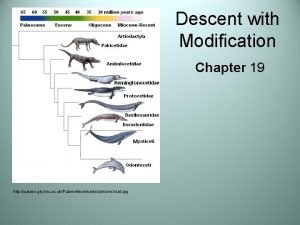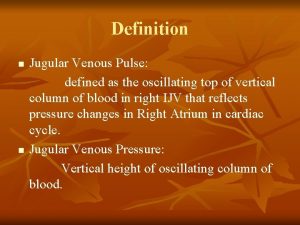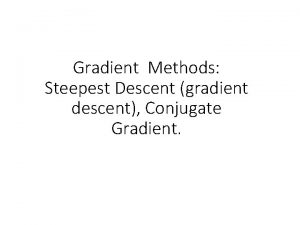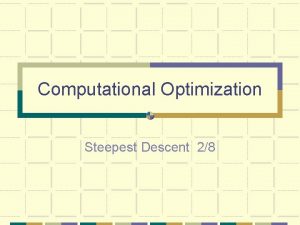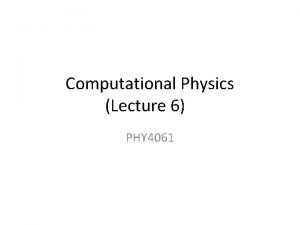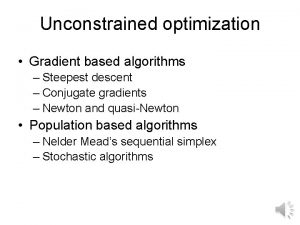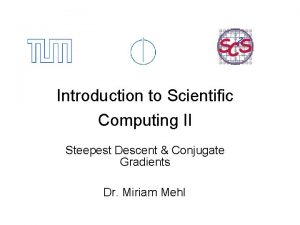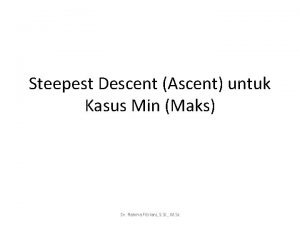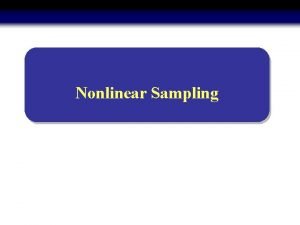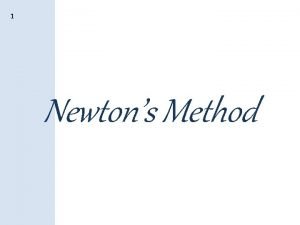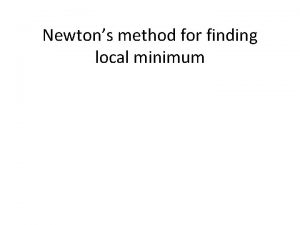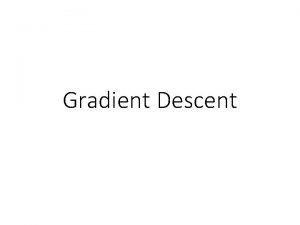Nonlinear systems Newtons method The steepest descent method




















![Newtonfun 3 v. m function xx=fun 3 v(f) s=symvar(f); xx=[]; for i=1: size(s, 1) Newtonfun 3 v. m function xx=fun 3 v(f) s=symvar(f); xx=[]; for i=1: size(s, 1)](https://slidetodoc.com/presentation_image/0d0835000ac2a8b6c13ec31d6b890072/image-21.jpg)


![Matlab codes feva. m function v=feva(f, x) s=symvar(f); xx=[]; for i=1: size(s, 1) ss=char(s(i)); Matlab codes feva. m function v=feva(f, x) s=symvar(f); xx=[]; for i=1: size(s, 1) ss=char(s(i));](https://slidetodoc.com/presentation_image/0d0835000ac2a8b6c13ec31d6b890072/image-24.jpg)

![function [J 1, J 2, J 3]=pdiff(s) Newtonpdiff. m 數值方法 2008, Applied Mathematics NDHU function [J 1, J 2, J 3]=pdiff(s) Newtonpdiff. m 數值方法 2008, Applied Mathematics NDHU](https://slidetodoc.com/presentation_image/0d0835000ac2a8b6c13ec31d6b890072/image-26.jpg)
![Example s='3*x 1 -cos(x 2*x 3)-1/2'; [J 1 J 2 J 3]=pdiff(s) J 1 Example s='3*x 1 -cos(x 2*x 3)-1/2'; [J 1 J 2 J 3]=pdiff(s) J 1](https://slidetodoc.com/presentation_image/0d0835000ac2a8b6c13ec31d6b890072/image-27.jpg)















- Slides: 42

Nonlinear systems Newton’s method The steepest descent method 數值方法 2008, Applied Mathematics NDHU 1

Nonlinear systems A general system of n nonlinear equations in n unknowns 數值方法 2008, Applied Mathematics NDHU 2

Example 數值方法 2008, Applied Mathematics NDHU 3

myfun function F = myfun(x) F(1) = 3*x(1)-cos(x(2)*x(3))-1/2; F(2) = x(1). ^2 -81*(x(2)+0. 1). ^2+sin(x(3))+1. 06; F(3) = exp(-x(1)*x(2))+20*x(3)+1/3*(10*pi-3); return 數值方法 2008, Applied Mathematics NDHU 4

數值方法 2008, Applied Mathematics NDHU 5

Solve nonlinear systems x 0= rand(1, 3)-0. 5; x = lsqnonlin(@myfun, x 0); y=myfun(x); sum(y. ^2); 數值方法 2008, Applied Mathematics NDHU 6

Demo_ex 1 demo_ex 1. m 數值方法 2008, Applied Mathematics NDHU 7

Newton’s method -Tangent line y=f(x) yn=f(xn) xn+1 數值方法 2008, Applied Mathematics NDHU xn x 8

Updating rule 數值方法 2008, Applied Mathematics NDHU 9

Newton’s method 數值方法 2008, Applied Mathematics NDHU 10

Flow Chart n=0; n=0 F guess x 0 Halting condition T 數值方法 2008, Applied Mathematics NDHU 11

Matlab coding Matlab modules: 1. 3 -variable function evaluation 2. Use symbolic differentiation to determine partial derivatives 3. Evaluate partial derivatives 4. Main program: use a while loop to update x iteratively 數值方法 2008, Applied Mathematics NDHU 12

Function evaluation s 1='3*x 1 -cos(x 2*x 3)-1/2'; f=inline(s 1); x=rand(1, 3); y=f(x(1), x(2), x(3)); 數值方法 2008, Applied Mathematics NDHU 13

Evaluation of vector function s 1='3*x 1 -cos(x 2*x 3)-1/2'; s 2='x 1. ^2 -81*(x 2+0. 1). ^2+sin(x 3)+1. 06'; s 3='exp(-x 1*x 2)+20*x 3+1/3*(10*pi-3)'; f 1=inline(s 1); f 2=inline(s 2); f 3=inline(s 3); x=rand(1, 3); Y=f 1(x(1), x(2), x(3)); Y=[Y f 2(x(1), x(2), x(3))]; Y=[Y f 3(x(1), x(2), x(3))]; 數值方法 2008, Applied Mathematics NDHU 14

Variant function form s='x 1+x 2'; f=inline(s); x=rand(1, 3); y=f(x(1), x(2), x(3)); s='x 1+x 2'; f=inline(s); x=rand(1, 3); y=f(x(1), x(2)); Error message: Too many input to inline function Correct codes 數值方法 2008, Applied Mathematics NDHU 15

s='x 1+x 3'; f=inline(s); x=rand(1, 3); y=f(x(1), x(3)); s='x 2+x 3'; f=inline(s); x=rand(1, 3); y=f(x(2), x(3)); Correct codes 數值方法 2008, Applied Mathematics NDHU 16

s='1'; f=inline(s); x=rand(1, 3); y=f(0); Correct codes s='x 1+x 2+x 3'; f=inline(s); x=rand(1, 3); y=f(x(1), x(2), x(3)); Correct codes 數值方法 2008, Applied Mathematics NDHU 17

symvar sc=symvar(f); l f denotes an inline function l sc is a cell structure l Symbols in f 數值方法 2008, Applied Mathematics NDHU 18

Symbols in an inline function s='x 1+x 2'; f=inline(s); s='x 1+x 3'; f=inline(s); s='1'; f=inline(s); s='x 2+x 3'; f=inline(s); s='x 1+x 2+x 3'; f=inline(s); sc=symvar(f); sc = 'x 1' 'x 2' y=f(x(1), x(2)); sc = 'x 2' 'x 3' 'x 1' 'x 3' y=f(x(1), x(3)); y=f(x(2), x(3)); 'x' y=f(0); 數值方法 2008, Applied Mathematics NDHU sc = 'x 1' 'x 2' 'x 3' y=f(x(1), x(2), x(3)); 19

3 -variable function evaluation xx=fun 3 v(f) f: an inline function l xx: a string for 3 -variable function evaluation l 數值方法 2008, Applied Mathematics NDHU 20
![Newtonfun 3 v m function xxfun 3 vf ssymvarf xx for i1 sizes 1 Newtonfun 3 v. m function xx=fun 3 v(f) s=symvar(f); xx=[]; for i=1: size(s, 1)](https://slidetodoc.com/presentation_image/0d0835000ac2a8b6c13ec31d6b890072/image-21.jpg)
Newtonfun 3 v. m function xx=fun 3 v(f) s=symvar(f); xx=[]; for i=1: size(s, 1) if i>1 xx=[xx ', ']; end arg=char(s(i)); switch arg case 'x' xx=[xx '0']; case 'x 1' xx=[xx 'x(1)']; case 'x 2' xx=[xx 'x(2)']; case 'x 3' xx=[xx 'x(3)']; end xx=['f(' xx ')']; return 數值方法 2008, Applied Mathematics NDHU 21

example s='x 1+x 2'; f=inline(s); s='x 1+x 3'; f=inline(s); s='x 2+x 3'; f=inline(s); s='1'; f=inline(s); s='x 1+x 2+x 3'; f=inline(s); xx=fun 3 v(f) x=[1 2 3] eval(xx) 數值方法 2008, Applied Mathematics NDHU 22

3 -variable function evaluation function v=feval 3 v(f, x) xx=fun 3 v(f); eval(xx) return 數值方法 2008, Applied Mathematics NDHU 23
![Matlab codes feva m function vfevaf x ssymvarf xx for i1 sizes 1 sscharsi Matlab codes feva. m function v=feva(f, x) s=symvar(f); xx=[]; for i=1: size(s, 1) ss=char(s(i));](https://slidetodoc.com/presentation_image/0d0835000ac2a8b6c13ec31d6b890072/image-24.jpg)
Matlab codes feva. m function v=feva(f, x) s=symvar(f); xx=[]; for i=1: size(s, 1) ss=char(s(i)); switch ss case 'x' xx=[xx 0]; case 'x 1' xx=[xx x(1)]; case 'x 2' xx=[xx x(2)]; case 'x 3' xx=[xx x(3)]; end xx=['f(' xx ')']; v=eval([sprintf(xx)]); return 數值方法 2008, Applied Mathematics NDHU 24

Partial derivation s='3*x 1 -cos(x 2*x 3)-1/2'; fx=inline(s); x 1=sym('x 1'); x 2=sym('x 2'); x 3=sym('x 3'); J 1=inline(diff(s, x 1)) J 2=inline(diff(s, x 2)) J 3=inline(diff(s, x 3)) 數值方法 2008, Applied Mathematics NDHU 25
![function J 1 J 2 J 3pdiffs Newtonpdiff m 數值方法 2008 Applied Mathematics NDHU function [J 1, J 2, J 3]=pdiff(s) Newtonpdiff. m 數值方法 2008, Applied Mathematics NDHU](https://slidetodoc.com/presentation_image/0d0835000ac2a8b6c13ec31d6b890072/image-26.jpg)
function [J 1, J 2, J 3]=pdiff(s) Newtonpdiff. m 數值方法 2008, Applied Mathematics NDHU 26
![Example s3x 1 cosx 2x 312 J 1 J 2 J 3pdiffs J 1 Example s='3*x 1 -cos(x 2*x 3)-1/2'; [J 1 J 2 J 3]=pdiff(s) J 1](https://slidetodoc.com/presentation_image/0d0835000ac2a8b6c13ec31d6b890072/image-27.jpg)
Example s='3*x 1 -cos(x 2*x 3)-1/2'; [J 1 J 2 J 3]=pdiff(s) J 1 = Inline function: J 1(x) = 3 J 2 = Inline function: J 2(x 2, x 3) = sin(x 2. *x 3). *x 3 J 3 = Inline function: J 3(x 2, x 3) = sin(x 2. *x 3). *x 2 數值方法 2008, Applied Mathematics NDHU 27

Partial derivatives s 1='3*x 1 -cos(x 2*x 3)-1/2'; s 2='x 1^2 -81*(x 2+0. 1)^2+sin(x 3)+1. 06'; s 3='exp(-x 1*x 2)+20*x 3+1/3*(10*pi-3)'; [J 1 J 2 J 3]=pdiff(s 1); [J 4 J 5 J 6]=pdiff(s 2); [J 7 J 8 J 9]=pdiff(s 3); 數值方法 2008, Applied Mathematics NDHU 28

Newtondemo. m 數值方法 2008, Applied Mathematics NDHU 29

Function x=Newton(s 1, s 2, s 3, x 0) s 1: string of function f 1 s 2: string of function f 2 s 3: string of function f 3 x 0: initial guess 數值方法 2008, Applied Mathematics NDHU 30

% % Determine F(1), F(2), F(3) by substituting x to f 1, f 2 and f 3 % % Determine J by substituting x to J 1, J 2, …, J 9 % % Update x 數值方法 2008, Applied Mathematics NDHU 31

Exercise Write matlab codes to implement the Newton’s method for solving a threevariable nonlinear system l Test your matlab function with the following nonlinear system l 數值方法 2008, Applied Mathematics NDHU 32

The steepest descent method is translated to minimize 數值方法 2008, Applied Mathematics NDHU 33

Gradient 數值方法 2008, Applied Mathematics NDHU 34

Iterative process 數值方法 2008, Applied Mathematics NDHU 35

數值方法 2008, Applied Mathematics NDHU 36

Newton’s method Steepest gradient descent method 數值方法 2008, Applied Mathematics NDHU 37

Steepest descent l Choose to minimize 數值方法 2008, Applied Mathematics NDHU 38

數值方法 2008, Applied Mathematics NDHU 39

Quadratic polynomial: 數值方法 2008, Applied Mathematics NDHU 40

數值方法 2008, Applied Mathematics NDHU 41

Function x=Steepest(s 1, s 2, s 3, x 0) Create three nonlinear inline functions Create nine inline functions for partial derivatives of the three nonlinear functions Set x to x 0 While the halting condition is not satisfied 1. 2. 3. 4. 5. Substitute x to all partial derivatives to form a 3 x 3 matrix J Substitute x to the three nonlinear functions Find optimal Update x by the steepest descent method Return x 數值方法 2008, Applied Mathematics NDHU 42
 Method of steepest descent
Method of steepest descent Steepest decent
Steepest decent Plant breeding
Plant breeding Single seed descent method
Single seed descent method Solving systems of nonlinear equations by elimination
Solving systems of nonlinear equations by elimination Linearization of nonlinear systems about equilibrium point
Linearization of nonlinear systems about equilibrium point Nonlinear systems of equations worksheet
Nonlinear systems of equations worksheet Equations example
Equations example Newtons method matlab
Newtons method matlab Secant method nonlinear equations
Secant method nonlinear equations Bisection method
Bisection method The work done by gravity during the descent of a projectile
The work done by gravity during the descent of a projectile Vertical descent angle
Vertical descent angle Top-down parser
Top-down parser Visual descent point
Visual descent point Eliminate left recursion calculator
Eliminate left recursion calculator Virgil bases his katabasis (descent) of aeneas on
Virgil bases his katabasis (descent) of aeneas on Texas descent and distribution before 1993
Texas descent and distribution before 1993 Gradient descent equation
Gradient descent equation Identical by descent vs identical by state
Identical by descent vs identical by state Recursive descent parser
Recursive descent parser Recursive descent parsing
Recursive descent parsing Limitations of recursive descent parser
Limitations of recursive descent parser Bann hadi
Bann hadi Linear regression multiple features
Linear regression multiple features Normal jvp
Normal jvp Visual descent point
Visual descent point Gradient descent java
Gradient descent java Partogram who guidelines
Partogram who guidelines Savagery in lord of the flies
Savagery in lord of the flies Kinship definition
Kinship definition Ambilineal descent
Ambilineal descent Recursive descent parser in c
Recursive descent parser in c Descent with modification: a darwinian view of life
Descent with modification: a darwinian view of life Chapter 22: descent with modification
Chapter 22: descent with modification What is descent with modification
What is descent with modification Chapter 22: descent with modification
Chapter 22: descent with modification Lineal kinship terminology
Lineal kinship terminology Common descent
Common descent Professor raymond flood
Professor raymond flood Linear regression gradient descent
Linear regression gradient descent Ameoba
Ameoba Jvp curve
Jvp curve
